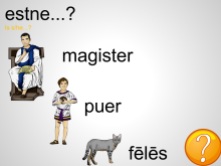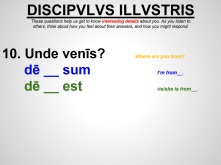Classroom MGMT
✔ Rules (DEA & CWB)
✔ Routines (Routines, Student Jobs, Interjections & Rejoinders)
✔ Brain Breaks
Comprehensibility
✔ Inclusion (Safety Nets, Gestures & Question Posters)
✔ Shelter Vocab (Super 7, TPR ppt, TPR Wall, and Word Wall)
✔ Unshelter Grammar (TPR Scenes)
Camaraderie
✔ Secrets (Class Password)
__ Students
By now you’ve noticed that my presentations are titled “Students and Stories in Latin.” Credit goes to Eric Herman for developing that course title intended to clearly distinguish a CI program from a more traditional one focusing on explicit rules, and unrealistic goals. Although we’ll get into the “stories” part of that shortly, today’s focus is on “students.”
People
It’s important to make a connection with each student. This connection doesn’t have to be uncomfortably personal, but it needs to be there. In addition to its MGMT purpose, Card Talk/Circling with Balls (CWB) starts to build that connection, but before talking about really interesting details of a student’s life (see Interview Program below), you more immediately need to talk about the people in the room, and it can’t be boring. Building Camaraderie requires a light mood, and humor is particularly effective. Instead of just saying who is who (e.g. boy, girl, student, teacher), students need to get the idea that your class is different in an awesome way, and it’s because class is fun and they get to express funny things in the target language (not forced speech, mind you, but through YOUR questioning).
Here’s a PPT presentation that helps you talk to students. It includes funny choices, and builds on the first Choral Translation and Reading from the Routines PPT with 7 more Readings. Since we’re talking about people, the focus is on the verb “to be,” but other sheltered verbs are recycled (e.g. means, is allowed, speaks) with unsheltered grammatical forms. It’s important not to view this as a prescriptive curriculum, but instead as a training tool to help you think about how to talk about students in the class, as well as create parallel readings that include vocabulary you’ve used. Here’s a tiled mosaic of slides from the presentation that give you a sense of how to create an enjoyable tone in class while talking to and about students:
So, go ahead and download the PPT and start clicking around:
Interview Program
DISCIPVLVS ILLVSTRIS is my preferred interview program, and it’s based on Bryce Hedstrom’s La Persona Especial. I don’t interview a student every day, although some teachers have stayed with a single student for 2 or 3 classes! You’ll have to read the room on this one, and of course, proficiency level plays a huge part in how much mileage you can get from students each day. Stay tuned for Checklist 10 for an example of what to do with student responses from the interview. Here’s a tiled mosaic of slides you’ll find from the PPT:
I’ve written about Discipulus Illustris already, so perhaps it’s best to download the PPT from the folder below and start clicking around. You’ll notice how the folder also includes a PDF Poster. Once students are more familiar with the process, you could switch to using that instead of the PPT presentation. That frees things up for more genuine communication between you, the student, and the class:









Pingback: CI Program Checklist: 9 of 13 | Magister P.
Pingback: CI Program Checklist: 10 of 13 | Magister P.
Pingback: CI Program Checklist: 11 of 13 | Magister P.
Pingback: CI Program Checklist: 12 of 13 | Magister P.
Pingback: CI Program Checklist: 13 of 13 | Magister P.
Pingback: CI Program Checklist: Summary | Magister P.